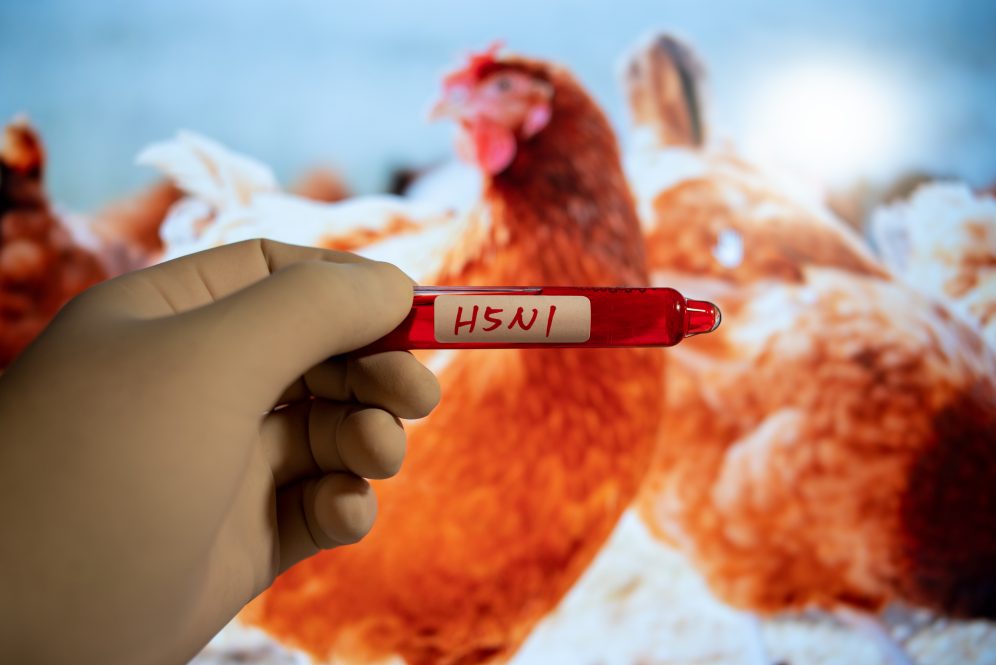
Since H5N1, or avian influenza, was first identified in 1996, the Centers for Disease Control and Prevention reports four known cases of bird flu in humans in the U.S. But three of those cases are from this year, all linked to an outbreak among cows. The CDC publishes a report on bird flu that updates Monday through Friday.
Dr. David Banach, UConn Health infectious diseases expert and hospital epidemiologist, provides some early analysis.
If we’ve known about bird flu for nearly three decades, why is it making news today?
Avian flu has been circulating in the U.S. and throughout the world; it’s not a totally new virus. We’ve seen strains of avian flu for decades. The CDC monitors this closely by tracking birds, and monitoring for signs off infection within a given flock.
More recently, there’s been concern about poultry, including residential poultry – people with their own chickens – and the potential to spread flu between birds in those types of settings. But now, cows have become infected, which hadn’t previously been seen to a significant extent. And now we know of the human cases, whose exposure was to cows that had become infected. So, this is a little bit different, in terms of mammal involvement and subsequent human infections. The fact that a bird is infecting mammals, then mammals are spreading it to each other, and now to humans, that’s the change.
What does this mean for our beef and dairy supply? Could I get sick by eating poultry or beef, or by drinking milk?
It seems like the virus doesn’t spread through milk or beef or poultry. This supports that doing things like pasteurizing milk and cooking meat adequately can help provide that extra layer of protection by killing off this particular virus as well as many other pathogens.
We know of four cases [as of June 4] of bird flu in humans in the U.S.: three this year and one two years ago. What, if anything, is that telling us?
It’s telling us that it’s important to look for this, that it’s out there, and that we need to be aware of it. We don’t know the full extent to which it spreads and how it can impact humans. There may be mild cases that just wouldn’t be detected, and individuals would recover on their own. So, it’s important to have this on the radar and to have active public health surveillance in order to really understand the extent to which it actually has spread.
How concerned should we be about transmission among people?
I think the risk to the general public is low, but I think it’s something we have to keep an eye on. It is important to know if we see spread to other mammals, signs that human-to-human transmission is occurring, or if we see larger outbreaks occurring. Those would be the kinds of things that would raise the level of concern for the public.
If I had to get a version of the flu, would I rather have regular flu or bird flu?
The problem with the bird flu is that it’s novel. These other flu viruses, you’ve likely encountered them in the past and you’ve probably had vaccines against them in the past, so you have some of that pre-existing immunity. People get infected with the flu every year and get some degree of immunity that’s protective. If it doesn’t completely protect you from getting the flu it can mitigate the severity of it. But the problem with these novel strains is that you may not have seen them in the past, so it would be the first time you’ve been exposed to them. That could result in a more severe infection.
What are the symptoms of bird flu and how do we differentiate bird flu from regular flu, COVID-19, RSV, pneumonia, and the common cold?
There’s a lot of overlap. This flu may present with similar symptoms to seasonal flu: fevers, muscle aches, just typical flu symptoms. I think we see similar kinds of symptoms. Interestingly, in two human cases, there was conjunctivitis associated with it, which we don’t see with regular flu. But the numbers aren’t big enough to make that strong association. But avian flu could be more severe because of that lack of pre-existing immunity.
And could one also argue that it could be less severe, because it’s only risen to two human cases, suggesting more people may have gotten it, but they were asymptomatic, it didn’t even bother them, and we’ll never know?
Exactly. We don’t know unless we look for it. And there are things going on at the public health level: for instance, they’ll take all the influenza A cases and test a subset to identify their strain or do further testing. So, we have systems in place to start to do that public health work to try to identify cases of avian flu.
Would treating it be similar to treating these other respiratory ailments?
Treatment is mostly supportive care. We also have antiviral medications, such as oseltamivir, which seem to be active against this particular strain. That has been part of the treatment of humans who have had avian flu infection. If you do have contact with poultry or mammals and develop flu symptoms, it’s important to inform your health care provider of this potential exposure.
And of course, this would be another reason to remember to wash your hands, and all those precautions?
Yes, and special precautions for people who are coming in contact with cows and poultry, who should be extra vigilant about hand washing. There are recommendations to wear a mask or a respirator and eye protection in cases where there’s going to be really close contact. In addition to hand washing, those are really critical if you’re going to be working with dairy cows or herds of animals that could be infected. The CDC provides some great guidance on how to best protect yourself in these situations.
If it can infect cows, what other animals could in infect? What about domestic pets? Are we going to have to start worrying about our dogs?
Birds predominantly have been the main concern. Whether your chicken flock can get infected and infect your dog, we still have more to learn about that.
But for the general population — of people — I think the risk is low, and people working closely with poultry, or now cows, should be attentive to an increased risk and should be taking precautions.



